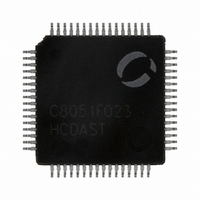C8051F023R Silicon Laboratories Inc, C8051F023R Datasheet - Page 217

C8051F023R
Manufacturer Part Number
C8051F023R
Description
IC 8051 MCU 64K FLASH 64TQFP
Manufacturer
Silicon Laboratories Inc
Series
C8051F02xr
Specifications of C8051F023R
Core Processor
8051
Core Size
8-Bit
Speed
25MHz
Connectivity
EBI/EMI, SMBus (2-Wire/I²C), SPI, UART/USART
Peripherals
Brown-out Detect/Reset, POR, PWM, Temp Sensor, WDT
Number Of I /o
32
Program Memory Size
64KB (64K x 8)
Program Memory Type
FLASH
Ram Size
4.25K x 8
Voltage - Supply (vcc/vdd)
2.7 V ~ 3.6 V
Data Converters
A/D 8x8b, 8x10b; D/A 2x12b
Oscillator Type
Internal
Operating Temperature
-40°C ~ 85°C
Package / Case
64-TQFP, 64-VQFP
Lead Free Status / RoHS Status
Contains lead / RoHS non-compliant
Eeprom Size
-
Other names
336-1035-2
Available stocks
Company
Part Number
Manufacturer
Quantity
Price
Company:
Part Number:
C8051F023R
Manufacturer:
Silicon Laboratories Inc
Quantity:
10 000
- Current page: 217 of 272
- Download datasheet (2Mb)
21.1.2. Mode 1: 8-Bit UART, Variable Baud Rate
Mode 1 provides standard asynchronous, full duplex communication using a total of 10 bits per data byte: one start
bit, eight data bits (LSB first), and one stop bit. Data are transmitted from the TX1 pin and received at the RX1 pin.
On receive, the eight data bits are stored in SBUF1 and the stop bit goes into RB81 (SCON1.2).
Data transmission begins when an instruction writes a data byte to the SBUF1 register. The TI1 Transmit Interrupt
Flag (SCON1.1) is set at the end of the transmission (the beginning of the stop-bit time). Data reception can begin
any time after the REN1 Receive Enable bit (SCON1.4) is set to logic 1. After the stop bit is received, the data byte
will be loaded into the SBUF1 receive register if the following conditions are met: RI1 must be logic 0, and if SM21
is logic 1, the stop bit must be logic 1.
If these conditions are met, the eight bits of data are stored in SBUF1, the stop bit is stored in RB81 and the RI1 flag
is set. If these conditions are not met, SBUF1 and RB81 will not be loaded and the RI1 flag will not be set. An inter-
rupt will occur if enabled when either TI1 or RI1 is set.
The baud rate generated in Mode 1 is a function of timer overflow, shown in Equation 21.1 and Equation 21.2.
UART1 can use Timer 1 operating in 8-Bit Auto-Reload Mode, or Timer 4 operating in Baud Rate Generator Mode to
generate the baud rate (note that the TX and RX clocks are selected separately). On each timer overflow event (a roll-
over from all ones - (0xFF for Timer 1, 0xFFFF for Timer 4) - to zero) a clock is sent to the baud rate logic.
Timer 4 is selected as TX and/or RX baud clock source by setting the TCLK1 (T4CON.4) and/or RCLK1 (T4CON.5)
bits, respectively (see
TCLK1 or RCLK1 is set to logic 1, Timer 4 is forced into Baud Rate Generator Mode, with SYSCLK / 2 as its clock
source. If TCLK1 and/or RCLK1 is logic 0, Timer 1 acts as the baud clock source for the TX and/or RX circuits,
respectively.
The Mode 1 baud rate equations are shown below, where T1M is the Timer 1 Clock Select bit (register CKCON),
TH1 is the 8-bit reload register for Timer 1, SMOD1 is the UART1 baud rate doubler (register PCON), and
[RCAP4H , RCAP4L] is the 16-bit reload register for Timer 4.
SPACE
MARK
BIT TIMES
BIT SAMPLING
START
Section “22. TIMERS” on page 225
BIT
BaudRate
BaudRate
Figure 21.4. UART1 Mode 1 Timing Diagram
Equation 21.1. Mode 1 Baud Rate using Timer 1
Equation 21.2. Mode 1 Baud Rate using Timer 4
D0
=
=
D1
------------------------------------------------------------------------------------------------- -
32
2
------------------ -
SMOD1
32
D2
65536
Rev. 1.4
D3
–
SYSCLK 12
------------------------------------------------------- -
SYSCLK
[
for complete timer configuration details). When either
RCAP4H RCAP4L
D4
256 TH1
–
,
D5
T1M 1
C8051F020/1/2/3
–
D6
]
D7
STOP
BIT
217
Related parts for C8051F023R
Image
Part Number
Description
Manufacturer
Datasheet
Request
R
Part Number:
Description:
SMD/C°/SINGLE-ENDED OUTPUT SILICON OSCILLATOR
Manufacturer:
Silicon Laboratories Inc
Part Number:
Description:
Manufacturer:
Silicon Laboratories Inc
Datasheet:
Part Number:
Description:
N/A N/A/SI4010 AES KEYFOB DEMO WITH LCD RX
Manufacturer:
Silicon Laboratories Inc
Datasheet:
Part Number:
Description:
N/A N/A/SI4010 SIMPLIFIED KEY FOB DEMO WITH LED RX
Manufacturer:
Silicon Laboratories Inc
Datasheet:
Part Number:
Description:
N/A/-40 TO 85 OC/EZLINK MODULE; F930/4432 HIGH BAND (REV E/B1)
Manufacturer:
Silicon Laboratories Inc
Part Number:
Description:
EZLink Module; F930/4432 Low Band (rev e/B1)
Manufacturer:
Silicon Laboratories Inc
Part Number:
Description:
I°/4460 10 DBM RADIO TEST CARD 434 MHZ
Manufacturer:
Silicon Laboratories Inc
Part Number:
Description:
I°/4461 14 DBM RADIO TEST CARD 868 MHZ
Manufacturer:
Silicon Laboratories Inc
Part Number:
Description:
I°/4463 20 DBM RFSWITCH RADIO TEST CARD 460 MHZ
Manufacturer:
Silicon Laboratories Inc
Part Number:
Description:
I°/4463 20 DBM RADIO TEST CARD 868 MHZ
Manufacturer:
Silicon Laboratories Inc
Part Number:
Description:
I°/4463 27 DBM RADIO TEST CARD 868 MHZ
Manufacturer:
Silicon Laboratories Inc
Part Number:
Description:
I°/4463 SKYWORKS 30 DBM RADIO TEST CARD 915 MHZ
Manufacturer:
Silicon Laboratories Inc
Part Number:
Description:
N/A N/A/-40 TO 85 OC/4463 RFMD 30 DBM RADIO TEST CARD 915 MHZ
Manufacturer:
Silicon Laboratories Inc
Part Number:
Description:
I°/4463 20 DBM RADIO TEST CARD 169 MHZ
Manufacturer:
Silicon Laboratories Inc











